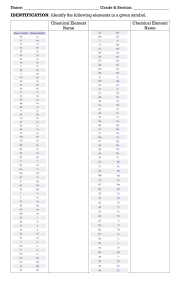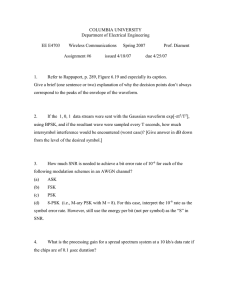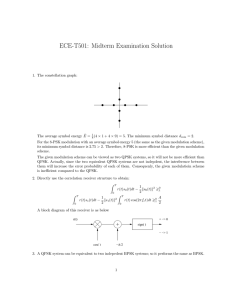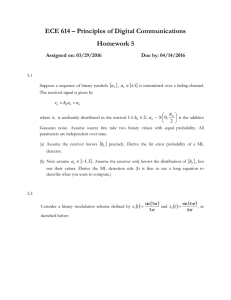Digital Passband Transmission: ASK, PSK, FSK, QAM
advertisement
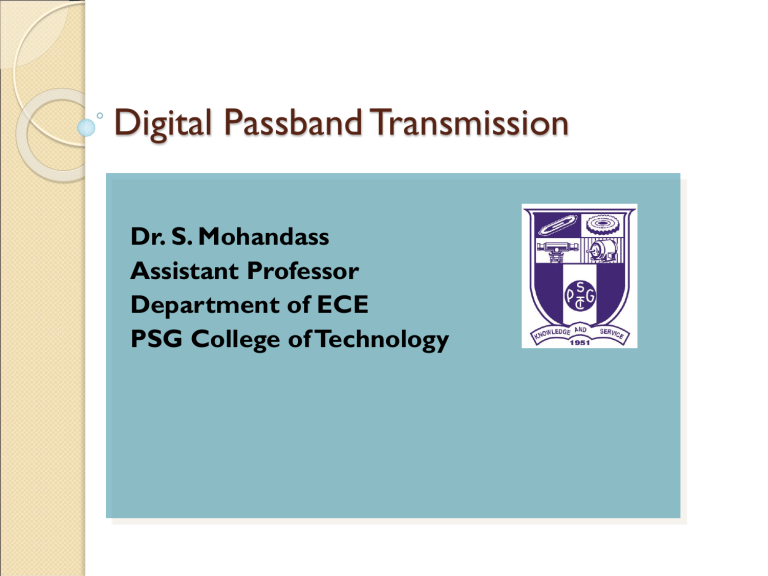
Digital Passband Transmission Dr. S. Mohandass Assistant Professor Department of ECE PSG College of Technology Contents Signaling over AWGN channels MAP and ML Rule Binary Signaling Schemes Amplitude-Shift Keying Phase-Shift Keying Frequency-Shift Keying Summary of Three Binary Signaling Schemes M-ary Digital Modulation Schemes 16-QAM Modulation Summary and Discussion References Signaling over AWGN channels The digital source output consists of a sequence of 1s and 0s, with each binary symbol being emitted every Tb seconds. The transmitting part of the digital communication system takes the 1s and 0s emitted by the source computer and encodes them into distinct signals denoted by s1(t) and s2(t), respectively, which are suitable for transmission over the analog channel. With the analog channel represented by an AWGN model, depicted in the Figure, the received signal is defined by where w(t) is the channel noise. The receiver has the task of observing the received signal x(t) for a duration of Tb seconds and then making an estimate of the transmitted signal si(t), or equivalently the ith symbol, i = 1, 2. However, owing to the presence of channel noise, the receiver will inevitably make occasional errors. The requirement, therefore, is to design the receiver so as to minimize the average probability of symbol error. 3 Geometric Representation of Signals The received signal vector x is given by, x = si + w, i = 1, 2,…, M where si is the transmitted signal vector and w is additive Gaussian noise vector. M denotes the possible symbols at the output of the source. • Let N be the number of basis functions involved in formulating the signal vector si for all i. 4 MAP Decision Rule 5 MAP Decision Rule 6 Maximum Likelihood Rule 7 Maximum Likelihood Rule 8 Observation space with N = 2 and M = 4 9 Digital Passband modulation Digital passband modulation techniques ◦ Amplitude-shift keying ◦ Phase-shift keying ◦ Frequency-shift keying Receivers ◦ Coherent detection The receiver is synchronized to the transmitter with respect to carrier phases ◦ Noncoherent detection The practical advantage of reduced complexity but at the cost of degraded performance At the receiving end, digital demodulation techniques encompass different forms, depending on whether the receiver is coherent or noncoherent Two ways of classifying digital modulation schemes are (a) by the type of modulation used, and (b) whether the transmitted data stream is in binary or M-ary form. 10 Binary modulation Given a binary source, the modulation process involves switching or keying the amplitude, phase, or frequency of a sinusoidal carrier wave c(t), between a pair of possible values in accordance with symbols 0 and 1. c(t ) Ac cos(2f ct c ) 1. Binary Amplitude-Shift Keying (BASK) The carrier amplitude is keyed between the two possible values used to represent symbols 0 and 1 2. Binary Phase-Shift Keying (BPSK) The carrier phase is keyed between the two possible values used to represent symbols 0 and 1. 3. Binary Frequency-Shift Keying (BFSK) The carrier frequency is keyed between the two possible values used to represent symbols 0 and 1. 11 Shift Keying Techniques 12 Digital Band-Pass modulation Amplitude of the unmodulated carrier is given by, Ac The sinusoidal carrier is given by, c(t ) 2 Tb 2 cos(2f ct c ) Tb The transmitted signal is given by, s (t ) b(t )c(t ) s(t ) 2 b(t ) cos(2f ct ) Tb where waveform b(t) depends on the modulation used. • Decreasing the bit duration Tb has the effect of increasing the transmission bandwidth requirement of a binary modulated wave. The spectrum of a digital modulated wave is centered on the carrier frequency fc and the bandwidth depends on Tb. 13 Binary Amplitude-Shift Keying (BASK) ◦ The ON-OFF signaling type of modulation takes following signal waveforms E , for binary symbol 1 b(t ) b for binary symbol 0 0, 2 Eb cos( 2f ct ), for symbol 1 s(t ) Tb 0, for symbol 0 ◦ The average transmitted signal energy is ( the two binary symbols must by equiprobable) Eb Eav 2 ◦ There is only one basis function used in BASK given by, (t ) 1 2 cos( 2f ct ) Tb 14 Generation and Detection of ASK Signals Generation of ASK signal ◦ By using a product modulator with two inputs The ON-OFF signal given by E , for binary symbol 1 b(t ) b for binary symbol 0 0, The sinusoidal carrier wave given by c(t ) 2 cos(2f c t ) Tb Detection of ASK signal ◦ The simplest way is to use an envelope detector, exploiting the non constant-envelope property of the BASK signal ◦ The other way is by using a correlation receiver 15 Probability of Error for ASK • In the on–off keying version of an ASK system, Symbol 1 is represented by transmitting a sinusoidal carrier o f amplitude , where Eb is the signal energy per bit and Tb is the bit duration. Symbol 0 is represented by switching off the carrier. • Assume that symbols 1 and 0 occur with equal probability • For an AWGN channel, the average probability of error for this ASK system under Coherent detection is given by, 16 Complementary Error Function (erfc) erfc( x) 2 2 exp z dz x 17 Phase-Shift Keying Binary Phase-Shift Keying (BPSK) • The pair of signals used to represent symbols 1 and 0, 2 Eb cos( 2f ct ), for symbol 1 correspond ing to i 1 T b si (t ) 2 Eb cos( 2f t ) 2 Eb cos( 2f t ), for symbol 0 correspond ing to i 2 c c Tb Tb • These are called antipodal signals: A pair of sinusoidal wave, which differ only in a relative phase-shift of π radians. • The transmitted energy per bit, Eb is constant, equivalently, the average transmitted power is constant. • Demodulation of BPSK cannot be performed using envelope detection, rather, coherent detection method is used. • The orthonormal basis function is given by, (t ) 1 2 cos( 2f ct ) Tb 18 Signal-space diagram of BPSK 19 Generation and Coherent Detection of BPSK Signals 1. Generation ◦ BPSK modulator consists of two components: 1) Non-return-to-zero level encoder The input binary data sequence is encoded in polar form with symbols 1 and 0 represented by the constant-amplitude levels ; √Eb and -√Eb 2) Product modulator Multiplies the level-encoded binary wave by the sinusoidal carrier c(t) of amplitude √2/Tb to produce the BPSK signal 20 2. Detection To make an optimum decision on the received signal x(t) in favor of symbol 1 or symbol 0, we assume that the receiver has access to a locally generated replica of the basis function In other words, the receiver is synchronized with the transmitter Two basic components in the binary PSK receiver are as follows: 1. Correlator, which correlates the received signal x(t) with the basis function on a bit-by-bit basis. 2. Decision device, which compares the correlator output against a zerothreshold, assuming that binary symbols 1 and 0 are equiprobable. If the threshold is exceeded, a decision is made in favor of symbol 1; if not, the decision is made in favor of symbol 0. 21 Probability of Error • The average probability of symbol error or, equivalently, the BER for binary PSK using coherent detection and assuming equiprobable symbols is given by • As we increase the transmitted signal energy per bit Eb for a specified noise spectral density N0/2, the message points corresponding to symbols 1 and 0 move further apart and the average probability of error Pe is correspondingly reduced in accordance with the above equation. 22 BER curve for BPSK 23 Quadriphase-Shift Keying (QPSK) ◦ An important goal of digital communication is the efficient utilization of channel bandwidth ◦ In QPSK (Quadriphase-shift keying) The phase of the sinusoidal carrier takes on one of the four equally spaced values, such as π/4, 3π/4, 5π/4, and 7π/4 2E cos 2f c t (2i 1) , 0 t T si (t ) T 4 0, elsewhere where i = 1,2,3,4; E is the transmitted signal energy per symbol and T is the symbol duration; fc is the carrier frequency. T 2Tb Tb is the bit duration. Each one of the four equally spaced phase values corresponds to a unique pair of bits called dibit 24 QPSK • QPSK transmitted signal si(t) can be redefined as, si (t ) 2E 2E cos (2i 1) cos( 2f ct ) sin (2i 1) sin( 2f ct ) T 4 T 4 where i = 1,2,3,4. Based on this representation, we make two observations: 1. There are two orthonormal basis functions, defined by a pair of quadrature carriers: 2. There are four message points, defined by the two-dimensional signal vector 25 QPSK Elements of the signal vectors, namely si1 and si2, have their values summarized in Table below; the first two columns give the associated dibit and phase of the QPSK signal. Accordingly, a QPSK signal has a two-dimensional signal constellation (i.e., N = 2) and four message points (i.e., M = 4) whose phase angles increase in a counterclockwise direction 26 Signal-space diagram of QPSK 27 Generation of QPSK Signals ◦ The incoming binary data stream is first converted into polar form by a non-return-to-zero level encoder ◦ The resulting binary wave is next divided by means of a demultiplexer into two separate binary waves a1(t) and a2(t) consisting of the oddand even- numbered input bits ◦ a1(t) and a2(t) are used to generate two BPSK signals by means of product modulators ◦ The two BPSK signals are added to produce the desired QPSK signals 28 QPSK Waveform 29 Coherent Detection of QPSK signals ◦ The QPSK receiver consists of an In-phase and quadrature channels with a common input. ◦ Each channel is made up of a product modulator, integrator, and decisionmaking device. ◦ The I- and Q- channels of the receiver recover the odd- and evennumbered input bits respectively ◦ By applying the outputs of these two channels to a multiplexer, the receiver recovers the original binary sequence 30 Error Probability of QPSK In a QPSK system operating on an AWGN channel, the received signal x(t) is defined by where w(t) is the sample function of a white Gaussian noise process of zero mean and power spectral density N0/2. The average probability of symbol error in terms of the ratio Eb/N0 is given by With Gray encoding used for the incoming symbols, we can fin d that the BER of QPSK is exactly 31 Comparison of BPSK and QPSK QPSK system achieves the same average probability of bit error as a binary PSK system for the same bit rate and the same Eb/N0 , but uses only half the channel bandwidth. For the same Eb/N0 and, therefore, the same average probability of bit error, a QPSK system transmits information at twice the bit rate of a binary PSK system for the same channel bandwidth. For a prescribed performance, QPSK uses channel bandwidth better than binary PSK, which explains the preferred use of QPSK over binary PSK in practice. 32 Binary Frequency-Shift Keying (BFSK) ◦ Each symbols are distinguished from each other by one of two transmitting sinusoidal waves that differ in frequency by a fixed amount 2 Eb cos( 2f1t ), for symbol 1 correspond ing to i 1 Tb si (t ) 2 Eb cos( 2f t ), for symbol 0 correspond ing to i 2 2 Tb ◦ Sunde’s BFSK When the frequencies f1 and f2 are chosen in such a way that they differ from each other by an amount equal to the reciprocal of the bit duration Tb ◦ It is a continuous-phase signal, in the sense that phase continuity is always maintained, including the inter-bit switching times. ◦ The most useful form for the set of orthonormal basis functions is described by where i=1,2 33 BFSK The coefficient sij where i = 1, 2 and j = 1, 2 is defined by Thus, unlike binary PSK, binary FSK is characterized by having a signalspace diagram that is two-dimensional (i.e., N = 2) with two message points (i.e., M = 2) The two message points are defined by the vectors and • The Euclidean distance ||s1-s2|| is equal to 34 BFSK Constellation diagram 35 BFSK Waveform 36 Generation and Detection of BFSK 37 Probability of Error • The average probability of bit error or, equivalently, the BER for binary FSK using coherent detection is given by, • A binary FSK receiver to maintain the same BER as in a binary PSK receiver, the bit energy-to-noise density ratio, Eb/N0, has to be doubled. • This result is in perfect accord with the signal-space diagra ms of BFSK and BPSK, where we see that in a BPSK system the Euclidean distance between the two message points is equa l to 2√Eb, whereas in a BFSK system the corresponding distan ce is √(2Eb). 38 M-ary Digital Modulation Schemes We send any one of M possible signals si(t), where i=1,2,…,M, during each signaling interval of duration T The requirement is to conserve bandwidth at the expense of both increased power and increased system complexity When the bandwidth of the channel is less than the required value, we resort to an M-ary modulation scheme for maximum bandwidth conservation M-ary Phase-Shift Keying ◦ If we take blocks of m bits to produce a symbol and use an M-ary PSK scheme with M=2m and symbol duration T=mTb ◦ The bandwidth required is proportional to 1/(mTb) ◦ The use of M-ary PSK provides a reduction in transmission bandwidth by a factor m=log2M 39 M-ary Phase-Shift Keying QPSK is a special case of the generic form of PSK commonly referred to as M-ary PSK In M-ary PSK, the phase of the carrier takes on one of M possible values: θi = 2(i – 1)π/M, where i = 1, 2,…,M. Accordingly, during each signaling interval of duration T, one of the following M possible signals is transmitted si (t ) 2E 2 cos 2f ct (i 1) , T M i 1,2,..., M 0t T 2 2 si (t ) E cos (i 1) cos( 2f c t ) M T 2 2 E sin (i 1) sin( 2f ct ), M T i 1,2,..., M 0t T where E is the signal energy per symbol. Each si(t) may be expanded in terms of the same two basis functions Φ1(t) and Φ2(t) The signal constellation of M-ary PSK is, therefore, two-dimensional. 40 M-ary Phase-Shift Keying Signal-Space Diagram ◦ Pair of orthogonal functions 1 (t ) 2 cos( 2f ct ), 0 t T T 2 (t ) 2 sin( 2f ct ), 0 t T T The average probability of symbol error for coherent M-ary PSK is given by, where it is assumed that M ≥ 4. For M = 4, it reduces to QPSK. 41 Signal-space diagram of 8-PSK • M-ary PSK is described in geometric terms by a constellation of M signal points distributed uniformly on a circle of radius √E • The figure in the Right, shows the constellation of 8-PSK, where 8 points are located on the circle of radius √E • Each signal point in the figure corresponds to the signal si(t) for a particular value of the index i. • The squared length from the origin to each signal point is equal to the signal energy E. 42 8-PSK The Euclidean distance for each of the two points m2 and m8 from m1 is (for M = 8) The average probability of symbol error for coherent M-ary PSK is given by where it is assumed that M≥4 43 M-ary Quadrature Amplitude Modulation (QAM) • In an M-ary PSK system, the in-phase and quadrature components of the modulated signal are interrelated in such a way that the envelope is constrained to remain constant and hence we have circular constellation of the message points. • However, if this constraint is removed so as to permit the in-phase and quadrature components to be independent, we get a new modulation scheme called M-ary QAM. • The QAM is a hybrid form of modulation, in that the carrier experiences amplitude as well as phase-modulation. • In M-ary PAM, the signal-space diagram is one-dimensional. M-ary QAM is a two dimensional generalization of M-ary PAM, in that its formulation involves two orthogonal passband basis functions: 44 M-ary Quadrature Amplitude Modulation (QAM) The mathematical description of the QAM signal is given by si (t ) i 0,1,..., M 1 2 E0 2 E0 ai cos( 2f ct ) bi sin( 2f ct ), 0t T T T where E0 is the energy of the message signal with the lowest amplitude The signal si(t) involves two phase-quadrature carriers, each one of which is modulated by a set of discrete amplitudes; hence the terminology “quadrature amplitude modulation.” The amplitude parameters ai and bi for in-phase and quadrature components are independent of each other for all i M-ary QAM is a hybrid form of M-ary modulation that combines M-ary ASK and M-ary PSK. In M-ary QAM, the constellation of message points depends on the number of possible symbols, M. 45 16-QAM Constellation Diagram In this example, the case of square constellation is considered , for which the number of bits per symbol is even (M=16). The message points in each quadrant are identified with Gray-encoded quadbits. 46 16-QAM Modulation The signal-space representation of M-ary QAM for M=16, shows that the message points form a square constellation Unlike M-ary PSK, the different signal points of M-ary QAM are characterized by different energy levels With an even number of bits per symbol L, we can write L=√M Therefore L=4 for 16-QAM modulation Each signal point in the constellation corresponds to a specific quadbit Under this condition, an M-ary QAM square constellation can always be viewed as the Cartesian product of a one-dimensional L-ary PAM constellation with itself. By definition, the Cartesian product of two sets of coordinates (representing a pair of one-dimensional constellations) is made up of the set of all possible ordered pairs of coordinates with the first coordinate in each such pair being taken from the first set involved in the product and the second coordinate taken from the second set in the product. 47 16-QAM Modulation The ordered pairs of coordinates naturally form a square matrix, as shown by To calculate the probability of symbol error for this M-ary QAM, we exploit the property: A QAM square constellation can be factored into the product of the corresponding L-ary PAM constellation with itself. 48 16-QAM Modulation • Two signal constellations for the 4-ary PAM, one vertically oriented along the Φ2-axis in part (a) of the figure, and the other horizontally oriented along the Φ1-axis in part (b) of the figure. • These two parts are spatially orthogonal to each other, accounting for the two-dimensional structure of the M-ary QAM 49 Probability of Error The probability of symbol error for M-ary QAM is approximately given by The transmitted energy in M-ary QAM is variable, in that its instantaneous value naturally depends on the particular symbol transmitted. Therefore, it is more logical to express Pe in terms of the average value of the transmitted energy rather than E0. Assuming that the L amplitude level s of the in-phase or quadrature component of the M-ary QAM signal are equally likely, we have The probability of symbol error for M-ary QAM in terms of Eav is given by 50 Summary and Discussion BASK, BPSK, and BFSK are the digital counterparts of amplitude modulation, phase modulation, and frequency modulation in Analog Communication Both BASK and BPSK exhibit discontinuity. It is possible to configure BFSK in such a way that phase continuity is maintained across the entire input binary data stream. Both BASK and BPSK are examples of linear modulation, with increasing complexity in going from BASK and BPSK. BFSK is in general an example of nonlinear modulation In coherent detection, the receiver must be synchronized with the transmitter in two respects – carrier phase and bit timing In noncoherent detection, the receiver ignores knowledge of the carrier phase between its own operation and that of the transmitter M-ary signaling schemes are preferred over binary modulation schemes when bandwidth is of profound importance 51 References Haykin S, “Digital Communication Systems”, John Wiley & Sons, 2014. Lathi B P, “Modern Digital and Analog communication Systems”, Oxford University Press, 2010. Proakis J.G and Salehi M, “Fundamentals of Communication Systems” Pearson, 2011. Bernard Sklar, “Digital Communications”, Pearson Education Asia, Sixth reprint, 2005. 52
